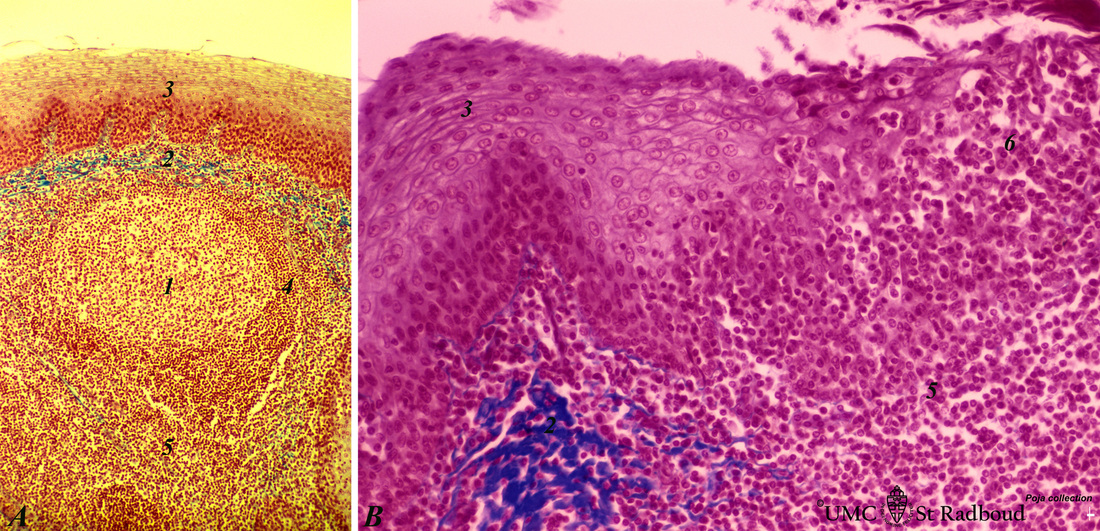2.4 POJA-L1062+1063
Title: Lingual tonsil (‘lymphoepithelial tissue’ gut-associated lymphatic tissue or GALT) (human)
Description: Stain: Azan.
(A): Left side shows a secondary lymphatic follicle (1) separated by the connective tissue of the proper lamina (2) from the lining non-keratinized stratified squamous epithelium (3). The mantle zone (4) is indicated by the peripheral dense aggregations of (memory) B lymphocytes. (5) Diffuse lymphatic tissue.
(B): Right side: a higher magnification reveals an intact epithelium (3) as shown on the left (A) picture, however at (6) the epithelium appears to be totally infiltrated by lymphocytes. The well-defined epithelial-connective tissue boundary is often distorted or even disappeared, due to expanding lymphatic tissues towards the lining epithelium, resulting in heavy lymphocytic infiltrations between the epithelial cells. The epithelial cells can desquamate subsequently to the lumen.
Background: The lingual tonsil consists of accumulations of bulging lingual lymphatic follicles in the dorsal part of the tongue behind the terminal sulcus, and belongs to the so-called Waldeyer’s ring of pharyngeal lymphatic tissue.
The cooperation between lymphatic and epithelial tissues is established to assure a specific environment for immune responses; hence the histological name lymphoepithelial tissue (i.e. gut-associated lymphatic tissue or GALT, mucosa-lymphatic tissue or MALT and bronchus-associated lymphatic tissue or BALT). Within the scope of this interaction expanding lymphatic tissue form the primary and secondary follicles reaches the lining epithelium followed by lymphocytic infiltrations between the epithelial cells, the so-called diapedesis. The cohesion between the squamous cells decreases and eventually the epithelial cells desquamate into the lumen of crypts, or clefts.
Keywords/Mesh: lymphatic tissue, lingual tonsil, follicle, GALT, histology, POJA collection
Title: Lingual tonsil (‘lymphoepithelial tissue’ gut-associated lymphatic tissue or GALT) (human)
Description: Stain: Azan.
(A): Left side shows a secondary lymphatic follicle (1) separated by the connective tissue of the proper lamina (2) from the lining non-keratinized stratified squamous epithelium (3). The mantle zone (4) is indicated by the peripheral dense aggregations of (memory) B lymphocytes. (5) Diffuse lymphatic tissue.
(B): Right side: a higher magnification reveals an intact epithelium (3) as shown on the left (A) picture, however at (6) the epithelium appears to be totally infiltrated by lymphocytes. The well-defined epithelial-connective tissue boundary is often distorted or even disappeared, due to expanding lymphatic tissues towards the lining epithelium, resulting in heavy lymphocytic infiltrations between the epithelial cells. The epithelial cells can desquamate subsequently to the lumen.
Background: The lingual tonsil consists of accumulations of bulging lingual lymphatic follicles in the dorsal part of the tongue behind the terminal sulcus, and belongs to the so-called Waldeyer’s ring of pharyngeal lymphatic tissue.
The cooperation between lymphatic and epithelial tissues is established to assure a specific environment for immune responses; hence the histological name lymphoepithelial tissue (i.e. gut-associated lymphatic tissue or GALT, mucosa-lymphatic tissue or MALT and bronchus-associated lymphatic tissue or BALT). Within the scope of this interaction expanding lymphatic tissue form the primary and secondary follicles reaches the lining epithelium followed by lymphocytic infiltrations between the epithelial cells, the so-called diapedesis. The cohesion between the squamous cells decreases and eventually the epithelial cells desquamate into the lumen of crypts, or clefts.
Keywords/Mesh: lymphatic tissue, lingual tonsil, follicle, GALT, histology, POJA collection

